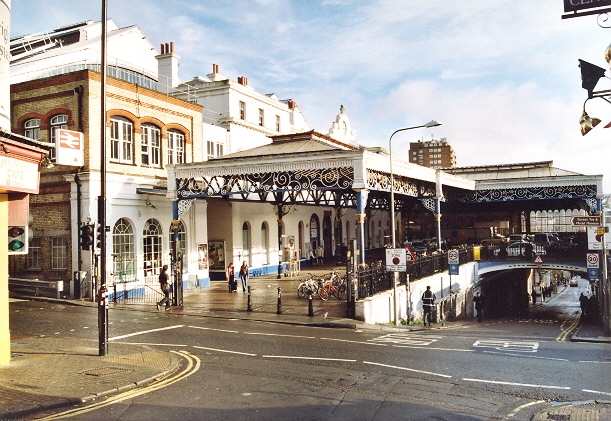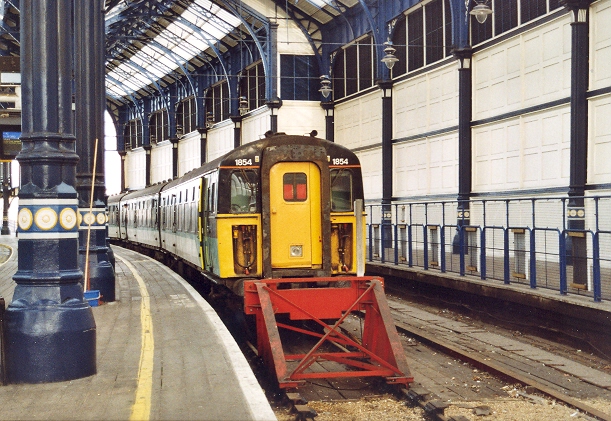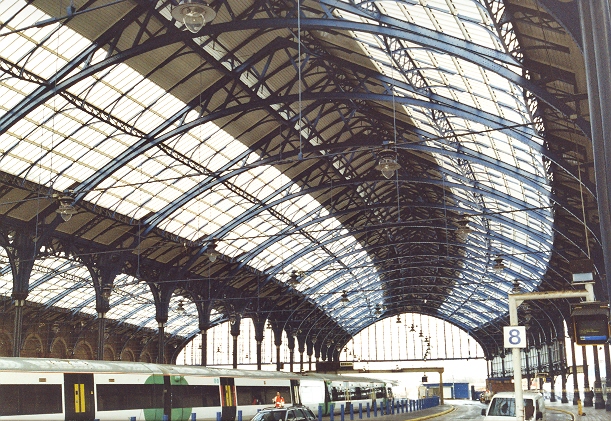
Brighton
By mid-1847 Brighton had no less than three separate main routes diverging from a single terminus: Brighton to London; Brighton to Portsmouth; Brighton to Bulverhythe (Hastings). Portsmouth had been reached on 14th June 1847 by the piecemeal extension of the westerly line from Shoreham. Traffic grew steadily, especially on the London to Brighton line, and the LB&SCR began looking at ways of perpetuating this trend. The company was aware of the lucrative gains to be had from serving the West End of London, thus in 1860 purchased an independent concern outright: the ''West End of London & Crystal Palace Railway'' (WEL&CPR). This company had built up a complex network of lines between Crystal Palace and Battersea, whilst yet another independent concern, namely the ''Victoria Station & Pimlico Railway Company'', had built a terminus station north of the Thames. The platform lines had been linked to the tracks of the WEL&CPR by means of Grosvenor Bridge, and now the LB&SCR had ready-made access to the West End. It began operating to and from Victoria on 1st October 1860.
Brighton was now connected with two major London termini: Victoria had now become the prime station for fast services to the seaside resort, whilst London Bridge handled the majority of slow and semi-fasts. Serving three separate routes with traffic increasing constantly, the terminus at Brighton was unable to cope and subsequently, in 1882, a comprehensive rebuilding programme was initiated. Seven platforms were to be increased to ten, whilst a brand new three-span trainshed roof was to replace the existing smaller structure. In the endeavour of keeping the platforms protected from the elements, the new cast-iron framed roof was constructed over the older structure whilst the latter was still standing. Once building of the new roof was completed, the older structure was dismantled within it, giving a good impression of how much smaller it was. A further modification was the erecting of a canopy to protect the street entrance, obscuring the fine Italian-styled buildings, but still retaining the traditional appearance of a station. The revised layout was completed in 1883 and platforms were generally dedicated to particular routes. Usually, platforms 1 to 3 served the line to Portsmouth, platforms 4 to 7 the main line to London, whilst finally, platforms 8 to 10 were used by services from Hastings.
From the early 1900s the bulk of expresses between Brighton and London were fronted by Class H1 / H2 Atlantic 4-4-2s and Class K 2-6-0s, with King Arthur Class locomotives arriving on the scene in 1925, the Southern Railway then in charge of operations. These locomotives were frequent performers on the LB&SCR-inaugurated all-Pullman ''Southern Belle'' from Victoria to Brighton. However, electrification came comparatively early on the London to Brighton route and by 1932, the Southern Railway had installed third rail along the main line, serving both Victoria and London Bridge stations. Signalling modernisation was undertaken in connection with this and in the same year, Brighton ''power box'' opened. Subsequently, the bulk of main line steam-hauled services were replaced by those operated by then new electric multiple units and the Southern Belle Pullman service was replaced by a five-coach Pullman EMU on 1st January 1933: the ''Brighton Belle''. Concurrent with this, the Brighton to West Worthing stretch of the West Coast line to Portsmouth received third rail, decreasing local journey times, whilst the eastern route through Lewes was electrified as far as Hastings and Ore in July 1935, the latter two of which were formerly in SE&CR territory.
Steam still survived on a few London-bound services from the terminus at Brighton and all freights in the area remained similar, many locomotives being provided by the large fourteen-road engine shed immediately north of the terminus. After Nationalisation, steam traction was more predominant on Bristol and Cardiff cross-country expresses from the coastal resort and by the the mid-1960s, Type 3 diesels began arriving in force, taking over both types of traffic. Also, the 6 PAN, 6 PUL, 2 HAL and 4 LAV Southern Railway electric multiple units which had been introduced on Brighton to London main line on completion of the various electrification schemes, were due for replacement and new breeds of EMU were to emerge as part of the Southern Region's Electrification Scheme. The year 1963 marked the introduction of new four-carriage 4 CIG and 4 BIG units, a batch of seven 4 CEP/BEP units also arriving in the same year. 4 Vep units arrived on the scene in the twilight of the 1960s, by which time the BR Mk 1-designed electric formations had a total monopoly of services to and from the terminus. Cardiff and Bristol expresses continued to be fronted by Class 33 diesels until May 1988, when the service ceased. The type was still used on the Saturdays-only Brighton to Exeter service, however, until 1993, Class 159s forming the services thereafter. From May 1988 onwards, direct Brighton to Bedford services were possible as a result of Snow Hill Tunnel reopening, by which time the terminus' structure had been painted into the vivid red of Network SouthEast. The façade of the twin span roof had also seen its glazing replaced by transparent corrugated plastic, but at least the roof remained with ''proper'' glass. Meanwhile, there had also been signalling alterations: on 30th March 1985, Brighton ''power box'' had closed and its functions transferred to Three Bridges.
The station looked a little tired when privatisation loomed, but Network SouthEast had performed well maintaining the huge structure on a shoestring. A much welcomed restoration effort began in August 1997, which included the re-glazing, repair and repainting of the trainshed roof, the largest constituent of the Grade II listed station. The forecourt canopy was not to receive new roof glazing, but was to see a new coat of paint. The station returned to its former glory when the completion of this momentous task came in the year 2000. This was followed on 18th July 2003 by the modernisation of departure facilities: the 1976 British Rail flickerboards were replaced with electronic TFT screens.

Now in our picture sequence we fast forward from the steam era to the present. This is the station
façade on 31st December 2004. From this viewpoint at least, the complex is of some architectural
note, with part of the parking / waiting area suspended over a descending road. It is indeed a very
spruce and presentable terminus. David Glasspool

4 Cig No. 1854 is seen stabled in platform 8 of the terminus on 31st December 2004. It had just
worked a service in from Seaford. David Glasspool

Restoration work on the station began in August 1997, which included re-glazing and repainting
the twin span trainshed - it was completed in 2000. The British Rail flicker boards were later replaced
in July 2003 with electronic displays. David Glasspool
Return to the Kent Rail Homepage or alternatively, check for Updates.
Website & Copyright information - Links - Contact the Webmaster
All content is copyright © David Glasspool unless otherwise stated